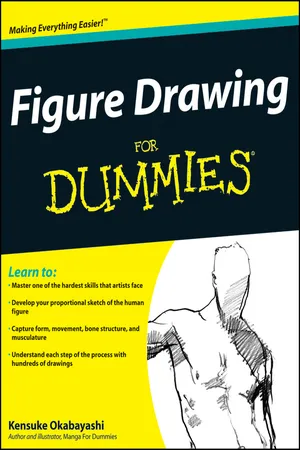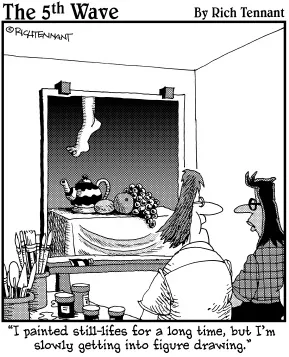
This is a test
- English
- ePUB (mobile friendly)
- Available on iOS & Android
eBook - ePub
Figure Drawing For Dummies
Book details
Book preview
Table of contents
Citations
About This Book
Figure Drawing For Dummies appeals to both new art students and veteran artists who find it difficult to proportionally draw the human form. The illustrations and examples in Figure Drawing For Dummies are designed to help readers capture this elusive figure.
Frequently asked questions
At the moment all of our mobile-responsive ePub books are available to download via the app. Most of our PDFs are also available to download and we're working on making the final remaining ones downloadable now. Learn more here.
Both plans give you full access to the library and all of Perlego’s features. The only differences are the price and subscription period: With the annual plan you’ll save around 30% compared to 12 months on the monthly plan.
We are an online textbook subscription service, where you can get access to an entire online library for less than the price of a single book per month. With over 1 million books across 1000+ topics, we’ve got you covered! Learn more here.
Look out for the read-aloud symbol on your next book to see if you can listen to it. The read-aloud tool reads text aloud for you, highlighting the text as it is being read. You can pause it, speed it up and slow it down. Learn more here.
Yes, you can access Figure Drawing For Dummies by Kensuke Okabayashi in PDF and/or ePUB format, as well as other popular books in Arte & Arte general. We have over one million books available in our catalogue for you to explore.
Information
Part I
Figure Drawing 101

In this part . . .
Welcome to Figure Drawing 101! Whether you’re drawing the human form for the first time or you’re a serious artist looking to hone your figure-drawing skills, this part is designed to get you started off on the right foot. No matter your background, you’re in for an awesome ride.
In this part, you get up to speed on rounding up the necessary drawing materials so you can get started on basic drawing principles and techniques. Throughout this part, you try some basic drawing exercises that are designed not only to loosen your wrist, but also to help you become familiar with the tools. You can think of them as warm-up exercises.
If you’re ready, turn the page and prepare to discover the world of figure drawing!
Chapter 1
Welcome to the Joys of Figure Drawing
In This Chapter



People surround you on a daily basis (unless you’re on a deserted island), yet the art of figure drawing remains full of puzzles and surprises. As someone who draws the figure, your mission (should you choose to accept it!) is to record your reaction to a figure’s pose or action.
Whether you’re a beginner who’s new to drawing the human figure or a serious art student looking to hone your figure-drawing skills, you’re in good hands. In this chapter, I introduce you to the fundamentals of figure drawing, including the materials and techniques you need. Sharpen your pencil, get out your sketchbook, and get ready to draw!
Finding the Right Drawing Materials
Like using the correct eating utensil at the dinner table, finding the right materials for figure drawing is important. Why? Nothing is more frustrating than trying to get a certain line quality (such as the fine line of an eyelid) when you have the wrong tool (like, in this instance, a thick charcoal stick).
In Chapter 2, I provide a list of drawing materials for your consideration. Although you don’t need to buy all the materials I list there at once, start off by visiting your local art store and trying out some pencils. I recommend starting with softer pencils, such as the Faber-Castell 9000 8B. Depending on how much time you have to draw, you may want to get at least five. In addition, I recommend bringing an 18-x-24-inch sketchpad to your figure-drawing class; it’s large enough to let you experiment with drawing various sizes, and it also gives the instructor enough space to make notes or drawing corrections on the side of your figure drawings.
Getting a Grip on Drawing Basics




Drawing the Head
No part of the human figure draws more attention than the head. It’s the area we use to recognize one another. The features that incorporate all five senses are also located on the head. In Part II, I give you a heads-up on the following topics:


Table of contents
- Cover
- Table of Contents
- Title Page
- Introduction
- Part I: Figure Drawing 101
- Part II: Off to a Head Start
- Part III: Building the Body
- Part IV: Sharpening Your Figure-Drawing Skills
- Part V: The Part of Tens
- Cheat Sheet

